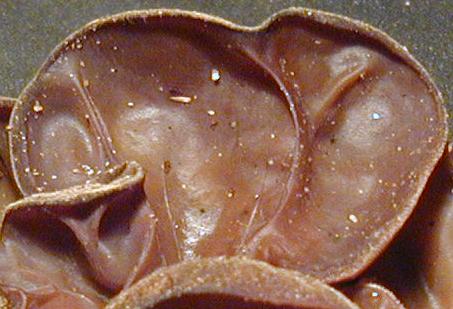

japonica Hara) sawdust-medium as compared to that on other sawdust-media (buna (Fagus crenata Blume) and mizunara (Quercus mongolica var. Five fusants exhibited superior mycelial growth on shirakamba (Betula platyphylla var. In regard to mycelial density, all of the 5 fusants were thicker compared to parental and monokaryotic strains. Concerning mycelial-growth rate, 5 fusants were similar to the parental and monokaryotic strain, Mo P 16. The optimal temperature of 5 fusants was 30 degrees centigrade in mycelial growth on a PDA medium. polytricha) and momokaryotic strains (Mo A 11 and Mo P 16). In addition, restriction endonuclease patterns of mitochondrial DNA of a fusant (Fu9) which formed small fruiting-bodies, were compared to those of parental strains (Auricularia auricula-judae and A. polytricha.įive fusants (Fu 9, 52, 58, 63 and 100) obtained by electrical protoplast fusion after treatment with two different metabolic inhibitors were investigated for mycelial-growth characteristics under various temperatures and on sawdust-medium, in paired cultures, by isozyme analysis and for biochemical test to clarify their characteristics. From these evidences, it is concluded that all of the 5 fusants are heterokaryon between A. By using restriction endonuclease analysis, the molecular size of mitochondrial DNA of Fu9, which had formed small fruiting-bodies, was confirmed to be 90.0kbp. On the other hand, phenoloxidase activities were not exhibited by Fu 9, 52, 58, and 63. In five fusants enzymic activity of alpha-galactosidase was observed. All of the 5 fusants were found to possess both specific bands which were present in the monokaryotic strains by analyzing electrophoretic isozyme.

In paired cultures between monokaryotic strains (Mo A 11 and Mo P 16) and 5 fusants, all the fusants formed antagonistic lines against both Mo A 11 and Mo P 16. An identification key for the accepted 37 species is proposed.Īuriculariaceae edible mushroom multi-gene analysis taxonomy.Five fusants (Fu 9, 52, 58, 63 and 100) obtained by electrical protoplast fusion after treatment with two different metabolic inhibitors were investigated for mycelial-growth characteristics under various temperatures and on sawdust-medium, in paired cultures, by isozyme analysis and for biochemical test to clarify their characteristics. Synopsis data on comparisons of species in the five complexes are provided. Morphological differences and phylogenetic relations of species in five Auricularia morphological complexes (the A. The morphological characters, photos, ecological traits, hosts and geographical distributions of those 37 species are outlined and discussed. delicata complex, are redefined, while A. tremellosa, respectively belonging to the A.

According to the morphological and/or molecular characters, 37 Auricularia species were identified. Phylogenetic analyses were based on ITS, nLSU, rpb1, and rpb2 sequences using methods of Maximum Likelihood and Bayesian Inference analyses. Morphological examinations and multi-gene phylogenetic analyses of 277 samples from 35 countries in Asia, Europe, North and South America, Africa, and Oceania were carried out. Auricularia has a worldwide distribution and is very important due to its edibility and medicinal properties.


 0 kommentar(er)
0 kommentar(er)
